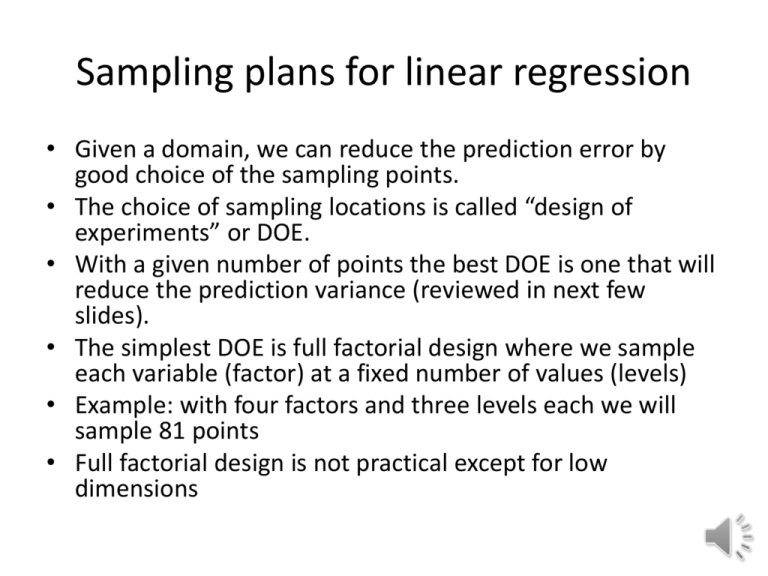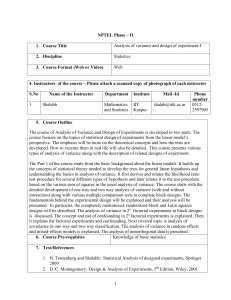Sampling plans
advertisement

Sampling plans for linear regression • Given a domain, we can reduce the prediction error by good choice of the sampling points. • The choice of sampling locations is called “design of experiments” or DOE. • With a given number of points the best DOE is one that will reduce the prediction variance (reviewed in next few slides). • The simplest DOE is full factorial design where we sample each variable (factor) at a fixed number of values (levels) • Example: with four factors and three levels each we will sample 81 points • Full factorial design is not practical except for low dimensions Linear Regression • Surrogate is linear n combination of 𝑛𝑏 yˆ bii (x) given shape functions i 1 • For linear 1 1 2 x approximation • Difference (error) e y b (x ) e y Xb between 𝑛𝑦 data and surrogate T T e e ( y X b ) (y Xb) • Minimize square error • Differentiate to obtain X T Xb X T y b nb j j i 1 i i j Model based error for linear regression • The common assumptions for linear regression – The true function is described by the functional form of the surrogate. – The data is contaminated with normally distributed error with the same standard deviation at every point. – The errors at different points are not correlated. • Under these assumptions, the noise standard deviation (called standard error) is estimated as eT e ˆ n y nb 2 • 𝜎 is used as estimate of the prediction error. Prediction variance n yˆ bii (x), • Linear regression model i 1 • Define x (m) i i (x), then yˆ x( m)T b, • With some algebra Var[ yˆ (x)] x ( m )T • Standard error b x (m) ( m )T (m) X X x , ( m )T X X x 2 s y ˆ x T T 1 1 x( m ) Prediction variance for full factorial design • Recall that standard error (square root of prediction 1 ( m ) ( m )T T variance is s y ˆ x X X x • For full factorial design the domain is normally a box. • Cheapest full factorial design: two levels (not good for quadratic polynomials). • For a linear polynomial standard error is then sy ˆ 2 n2 1 x12 x22 .... xn2 • Maximum error at vertices n 1 s y ˆ 2n • What does the ratio in the square root represent? Quadratic Polynomials • A quadratic polynomial has (n+1)(n+2)/2 coefficients, so we need at least that many points. • Need at least three different values of each variable. • Simplest DOE is three-level, full factorial design • Impractical for n>5 • Also unreasonable ratio between number of points and number of coefficients • For example, for n=8 we get 6561 samples for 45 coefficients. • My rule of thumb is that you want twice as many points as coefficients Central Composite Design • Includes 2n vertices, 2n face points plus nc repetitions of central point • Can choose α so to – achieve spherical design – achieve rotatibility (prediction 4 variance is spherical) 𝛼 = 𝑉 – Stay in box (face centered) FCCCD • Still impractical for n>8 Repeated observations at origin • Unlike linear polynomials, prediction variance is high at origin. • Repetition at origin decreases variance there and improves stability (uniformity). • Repetition also gives an independent measure of magnitude of noise. • Can be used also for lack-of-fit tests. Without repetition (9 points) • Contours of prediction variance for spherical CCD design. Center repeated 5 times (13 points) . • With five repetitions we reduce the maximum prediction variance and greatly improve the uniformity. • Five points is the optimum for uniformity. D-optimal design • Maximizes the determinant of XTX to reduce the volume of uncertainties about the coefficients. • Example: Given the model y=b1x1+b2x2, and the two data points (0,0) and (1,0), find the optimum third data point (p,q) in the unit square. 0 0 • We have 2 X 1 0 p q 1 p X X pq T pq T 2 det( X X ) q q2 • So that the third point is (p,1), for any value of p • Finding D-optimal design in higher dimensions is a difficult optimization problem often solved heuristically Matlab example 1 0.8 >> ny=6;nbeta=6; >> [dce,x]=cordexch(2,ny,'quadratic'); >> dce' 1 1 -1 -1 0 1 -1 1 1 -1 -1 0 scatter(dce(:,1),dce(:,2),200,'filled') >> det(x'*x)/ny^nbeta ans = 0.0055 With 12 points: >> ny=12; >> [dce,x]=cordexch(2,ny,'quadratic'); >> dce' -1 1 -1 0 1 0 1 -1 1 0 -1 1 -1 -1 -1 1 1 -1 -1 0 0 0 scatter(dce(:,1),dce(:,2),200,'filled') >> det(x'*x)/ny^nbeta ans =0.0102 0.6 0.4 0.2 0 -0.2 -0.4 -0.6 -0.8 -1 -1 -0.8 -0.6 -0.4 -0.2 0 0.2 0.4 0.6 0.8 1 1 0.8 0.6 0.4 0.2 1 1 0 -0.2 -0.4 -0.6 -0.8 -1 -1 -0.8 -0.6 -0.4 -0.2 0 0.2 0.4 0.6 0.8 1 Problems DOE for regression • What are the pros and cons of D-optimal designs compared to central composite designs? • For a square, use Matlab to find and plot the D-optimal designs with 10, 15, and 20 points. Space-Filling DOEs • Design of experiments (DOE) for noisy data tend to place points on the boundary of the domain. • When the error in the surrogate is due to unknown functional form, space filling designs are more popular. • These designs use values of variables inside range instead of at boundaries • Latin hypercubes uses as many levels as points • Space-filling term is appropriate only for low dimensional spaces. • For 10 dimensional space, need 1024 points to have one per orthant. Monte Carlo sampling • Regular, grid-like DOE runs the risk of deceptively accurate fit, so randomness appeals. • Given a region in design space, we can assign a uniform distribution to the region and sample points to generate DOE. • It is likely, though, that some regions will be poorly sampled • In 5-dimensional space, with 32 sample points, what is the chance that all orthants will be occupied? – (31/32)(30/32)…(1/32)=1.8e-13. Example of MC sampling 1 3 0.8 2 0.6 0.4 1 0.2 0 0 0.5 1 0 0 0.5 1 6 • With 20 points there is evidence of both clamping and holes • The histogram of x1 (left) and x2 (above) are not that good either. 4 2 0 0 0.5 1 Latin Hypercube sampling • Each variable range divided into ny equal probability intervals. One point at each interval. 1 2 2 3 3 4 4 1 5 5 Latin Hypercube definition matrix • For n points with m variables: m by n matrix, with each column a permutation of 1,…,n • Examples 1 2 4 1 3 2 1 3 2 4 1 2 3 3 3 2 4 1 • Points are better distributed for each variable, but can still have holes in m-dimensional space. Improved LHS • Since some LHS designs are better than others, it is possible to try many permutations. What criterion to use for choice? • One popular criterion is minimum distance between points (maximize). Another is correlation between variables (minimize). 1 • Matlab lhsdesign uses by default 5 iterations to look for “best” design. • The blue circles were obtained with the minimum distance criterion. Correlation coefficient is -0.7. • The red crosses were obtained with correlation criterion, the coefficient is -0.055. 0.9 0.8 0.7 0.6 0.5 0.4 0.3 0.2 0.1 0 0 0.1 0.2 0.3 0.4 0.5 0.6 0.7 0.8 0.9 1 More iterations • With 5,000 iterations the two sets of designs improve. • The blue circles, maximizing minimum distance, still have a correlation coefficient of 0.236 compared to 0.042 for the red crosses. 1 0.9 • With more iterations, maximizing the minimum distance also reduces the size of the holes better. • Note the large holes for the crosses around (0.45,0.75) and around the two left corners. 0.8 0.7 0.6 0.5 0.4 0.3 0.2 0.1 0 0 0.1 0.2 0.3 0.4 0.5 0.6 0.7 0.8 0.9 1 Reducing randomness further • We can reduce randomness further by putting the point at the center of the box. • Typical results are shown in the figure. • With 10 points, all will be at 0.05, 0.15, 0.25, and so on. 1 0.9 0.8 0.7 0.6 0.5 0.4 0.3 0.2 0.1 0 0 0.1 0.2 0.3 0.4 0.5 0.6 0.7 0.8 0.9 1 Problems LHS designs • Using 20 points in a square, generate a maximum-minimum distance LHS design, and compares its appearance to a D-optimal design. • Compare their maximum minimum distance and their det(XTX)







